-
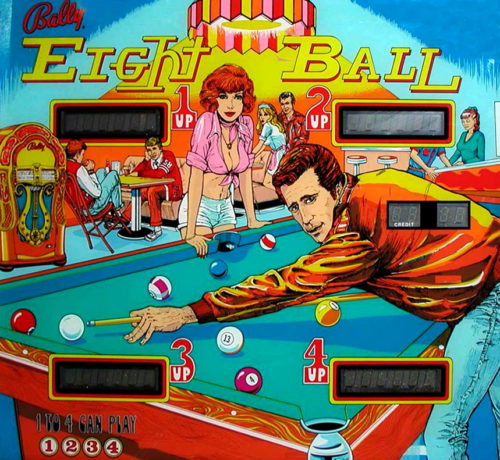 If you like “Happy Days” of TV fame, you’ll immediately notice “The Fonz” on the backglass. George Christian designed this machine and Paul Faris penned the artwork package. The machine was very popular in the early days of solid-state pinball. 20,230 games were made and most of them were played down to the wood subsurface under the artwork due to excessive play. The pool-themed game is set up so that players one and three’s goal is to score balls 1 to 7 and players two and four are after the 9 to 15 balls. Once completed, the eight-ball target lights. This machine has a built-in memory recall of each player’s efforts and the game continues on your next ball where you left off. Bonus awards are 3,000 points per ball lit with a holdover feature from your previous accomplishments. The right bonus lane advances the winnings by 2x, 3x, 5x , super bonus, extra balls and specials.
If you like “Happy Days” of TV fame, you’ll immediately notice “The Fonz” on the backglass. George Christian designed this machine and Paul Faris penned the artwork package. The machine was very popular in the early days of solid-state pinball. 20,230 games were made and most of them were played down to the wood subsurface under the artwork due to excessive play. The pool-themed game is set up so that players one and three’s goal is to score balls 1 to 7 and players two and four are after the 9 to 15 balls. Once completed, the eight-ball target lights. This machine has a built-in memory recall of each player’s efforts and the game continues on your next ball where you left off. Bonus awards are 3,000 points per ball lit with a holdover feature from your previous accomplishments. The right bonus lane advances the winnings by 2x, 3x, 5x , super bonus, extra balls and specials. -
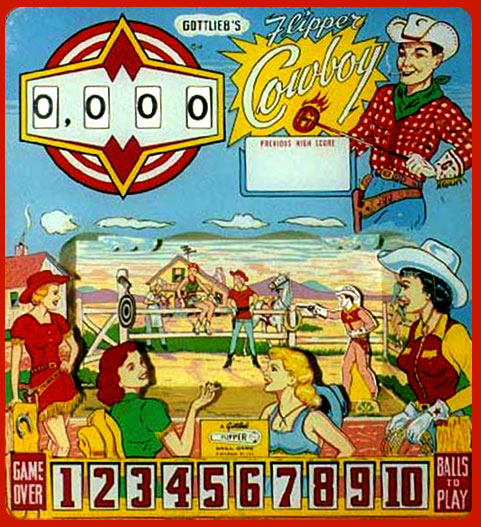 This Gottlieb game is one of the five in the museum of the “flipper” series from Gottlieb. These games are all add-a-ball games. The layout of this game parallels a future Gottlieb classic by the name of “Buckaroo” (also in the museum). 1,550 of these machines were manufactured. Wayne Neyens designed the game and Roy Parker established the art package. Fifteen targets on the roto-target are present and spinning the roto would bring up new numbers to complete. If you are skillful enough to sequence four numbers in a row, an extra ball is awarded. The bull’s-eye target awards an extra ball also. Each time an extra ball is awarded, the backglass animation activates. The cowboy shoots at the targets, which causes them to spin. No match feature here and tilting the game forfeits the ball in play as well as a future ball in play.
This Gottlieb game is one of the five in the museum of the “flipper” series from Gottlieb. These games are all add-a-ball games. The layout of this game parallels a future Gottlieb classic by the name of “Buckaroo” (also in the museum). 1,550 of these machines were manufactured. Wayne Neyens designed the game and Roy Parker established the art package. Fifteen targets on the roto-target are present and spinning the roto would bring up new numbers to complete. If you are skillful enough to sequence four numbers in a row, an extra ball is awarded. The bull’s-eye target awards an extra ball also. Each time an extra ball is awarded, the backglass animation activates. The cowboy shoots at the targets, which causes them to spin. No match feature here and tilting the game forfeits the ball in play as well as a future ball in play. -
 Centipede is a vertically oriented shoot ‘em up arcade game produced by Atari, Inc. in 1981. The game was designed by Ed Logg along with Dona Bailey, one of the few female game programmers in the industry at this time. It was also one of the first arcade coin-operated games to have a significant female player base, after Pac-Man. The player defends against centipedes, spiders, scorpions and fleas, completing a round after eliminating the centipede that winds down the playing field. The player is represented by a small, “somewhat humanoid head” at the bottom of the screen. The player moves the character about the bottom area of the screen with a trackball and fires laser shots at a centipede advancing from the top of the screen down through a field of mushrooms. Shooting any section of the centipede creates a mushroom; shooting one of the middle segments splits the centipede into two pieces at that point. Each piece then continues independently on its way down the board, with the first section of the rear piece becoming a new head. If the head is destroyed, the section behind it becomes the next head. The centipede starts at the top of the screen, traveling either left or right. When it hits a mushroom or the edge of the screen, it drops one level and switches direction. Thus, more mushrooms on the screen cause the centipede to descend more rapidly. The player can destroy mushrooms by shooting them, but each takes four hits to destroy. If the centipede reaches the bottom of the screen, it moves back and forth within the player area and one-segment “head” centipedes are periodically added. This continues until the player has eliminated both the original centipede and all heads. When all the centipede’s segments are destroyed, a new centipede forms at the top of the screen. Every time a centipede is eliminated, however, the next one is one segment shorter and is accompanied by one additional, fast-moving “head” centipede. A player loses a life when hit by a centipede or another enemy, such as a spider or a flea. The flea leaves mushrooms behind when fewer than five are in the player area, though the number required increases with level of difficulty. Spiders move across the player area in a zig-zag fashion and occasionally eat some of the mushrooms. Scorpions poison every mushroom they touch, but these never appear in the player’s movement region. A centipede touching a poisoned mushroom hurtles straight toward the player’s area. Upon reaching the player’s area, the centipede returns to normal behavior.
Centipede is a vertically oriented shoot ‘em up arcade game produced by Atari, Inc. in 1981. The game was designed by Ed Logg along with Dona Bailey, one of the few female game programmers in the industry at this time. It was also one of the first arcade coin-operated games to have a significant female player base, after Pac-Man. The player defends against centipedes, spiders, scorpions and fleas, completing a round after eliminating the centipede that winds down the playing field. The player is represented by a small, “somewhat humanoid head” at the bottom of the screen. The player moves the character about the bottom area of the screen with a trackball and fires laser shots at a centipede advancing from the top of the screen down through a field of mushrooms. Shooting any section of the centipede creates a mushroom; shooting one of the middle segments splits the centipede into two pieces at that point. Each piece then continues independently on its way down the board, with the first section of the rear piece becoming a new head. If the head is destroyed, the section behind it becomes the next head. The centipede starts at the top of the screen, traveling either left or right. When it hits a mushroom or the edge of the screen, it drops one level and switches direction. Thus, more mushrooms on the screen cause the centipede to descend more rapidly. The player can destroy mushrooms by shooting them, but each takes four hits to destroy. If the centipede reaches the bottom of the screen, it moves back and forth within the player area and one-segment “head” centipedes are periodically added. This continues until the player has eliminated both the original centipede and all heads. When all the centipede’s segments are destroyed, a new centipede forms at the top of the screen. Every time a centipede is eliminated, however, the next one is one segment shorter and is accompanied by one additional, fast-moving “head” centipede. A player loses a life when hit by a centipede or another enemy, such as a spider or a flea. The flea leaves mushrooms behind when fewer than five are in the player area, though the number required increases with level of difficulty. Spiders move across the player area in a zig-zag fashion and occasionally eat some of the mushrooms. Scorpions poison every mushroom they touch, but these never appear in the player’s movement region. A centipede touching a poisoned mushroom hurtles straight toward the player’s area. Upon reaching the player’s area, the centipede returns to normal behavior. -
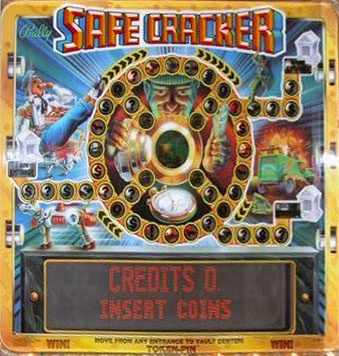 Safecracker is a pinball machine with a safecracking theme, designed by Pat Lawlor, and distributed by Midway (under the Bally label). It was created in 1996. About 1148 were manufactured. Safecracker differs from a standard pinball game in that the player is playing against the clock as opposed to having a certain number of balls available. If the player loses a ball, as long as there is time left on the clock they can continue playing. The machine is smaller in size than a standard pinball machine. The main objective of the game is to break into the bank’s safe. The game can be broken into 3 areas of play: The pinball playfield has numerous targets, the completion of which will allow entry into the bank via the rooftop, the cellar, or the front door. Once the player has entered the bank, the game changes to a boardgame that takes place on the backglass. Using the flipper buttons to make choices, the player rolls dice and moves their piece around the board while being chased by the security guard. The object of this portion of the game is to advance to the center of the game board (where the safe is located) before being caught by the guard. If the player is successful, the game will eject a “magic token” from the bank vault for the player to catch as it rolls down the playfield glass. After the player is done with the regular game, they can deposit their “magic token” into the token slot of the machine to activate a special game mode called “Assault on the Vault”. In this frenzied 4-ball multiball mode, players have 90 seconds to hit as many drop target and ramp shots as possible to break into the bank vault.
Safecracker is a pinball machine with a safecracking theme, designed by Pat Lawlor, and distributed by Midway (under the Bally label). It was created in 1996. About 1148 were manufactured. Safecracker differs from a standard pinball game in that the player is playing against the clock as opposed to having a certain number of balls available. If the player loses a ball, as long as there is time left on the clock they can continue playing. The machine is smaller in size than a standard pinball machine. The main objective of the game is to break into the bank’s safe. The game can be broken into 3 areas of play: The pinball playfield has numerous targets, the completion of which will allow entry into the bank via the rooftop, the cellar, or the front door. Once the player has entered the bank, the game changes to a boardgame that takes place on the backglass. Using the flipper buttons to make choices, the player rolls dice and moves their piece around the board while being chased by the security guard. The object of this portion of the game is to advance to the center of the game board (where the safe is located) before being caught by the guard. If the player is successful, the game will eject a “magic token” from the bank vault for the player to catch as it rolls down the playfield glass. After the player is done with the regular game, they can deposit their “magic token” into the token slot of the machine to activate a special game mode called “Assault on the Vault”. In this frenzied 4-ball multiball mode, players have 90 seconds to hit as many drop target and ramp shots as possible to break into the bank vault. -
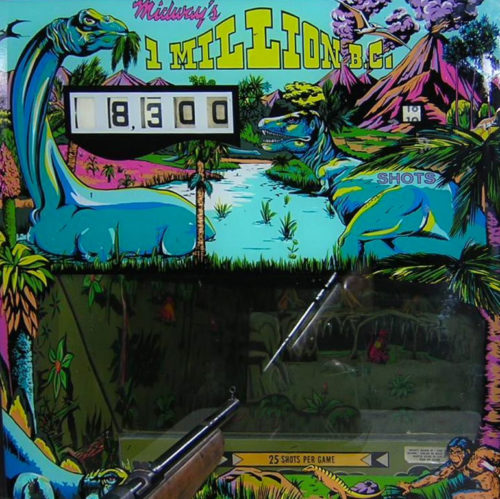
-
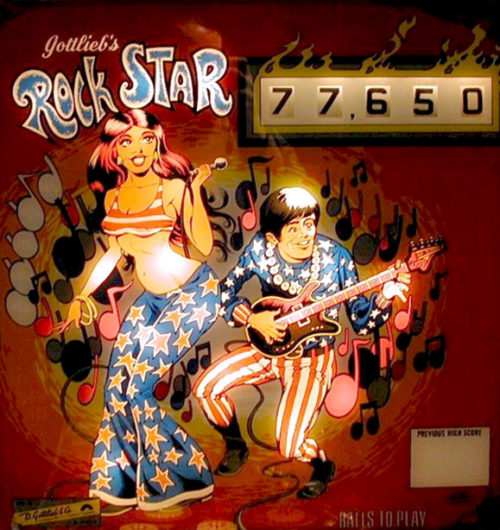 The game before you is extremely rare with only 278 screwed together at the Chicago Gottlieb factory. This one-player electromechanical add-a-ball game was designed by John Osbourne with art by Gordon Morison. A replay version was also designed by the name of Blue Note. The object of this machine is to complete all the notes down the left side of the playfield. Doing so activates the classic “wow” feature which, when hit, awards one free ball. A reset is in your future once your current ball drains. Score is another way to achieve longer play by winning extra balls. The spinner in the middle of the playfield awards big points when 1,000 points is lit; each spin of the target awards 1,000 points plus number of revolutions spun. A nice retro art package completes this rare machine.
The game before you is extremely rare with only 278 screwed together at the Chicago Gottlieb factory. This one-player electromechanical add-a-ball game was designed by John Osbourne with art by Gordon Morison. A replay version was also designed by the name of Blue Note. The object of this machine is to complete all the notes down the left side of the playfield. Doing so activates the classic “wow” feature which, when hit, awards one free ball. A reset is in your future once your current ball drains. Score is another way to achieve longer play by winning extra balls. The spinner in the middle of the playfield awards big points when 1,000 points is lit; each spin of the target awards 1,000 points plus number of revolutions spun. A nice retro art package completes this rare machine. -
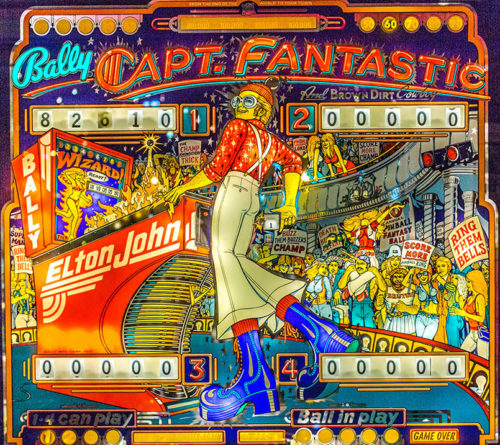 This game is considered to be the #3 game of the ’70s. It was released in June, designed by Greg Kmiec and art by Dave Christiansen. It had a production run of 16,200 units, a record to that date for production by Bally. The game has a rock star tie in the form of Elton John, who was at his peak back then. The movie “Tommy” was also an influence for the game’s graphics. The triple flipper arrangement of the game made for fast action on the playfield. A bonus feature is present, a 5-bank drop target that when hit, advances through extra ball and then special. A free ball gate, when activated, extends the ball’s life. This game is one of the last most collectible electromechanical-era games produced. It was the complementary game to Bally’s Wizard pinball which, again, found its theme based on the “Tommy” movie by The Who. Celebrity tie-ins were found to be big sellers.
This game is considered to be the #3 game of the ’70s. It was released in June, designed by Greg Kmiec and art by Dave Christiansen. It had a production run of 16,200 units, a record to that date for production by Bally. The game has a rock star tie in the form of Elton John, who was at his peak back then. The movie “Tommy” was also an influence for the game’s graphics. The triple flipper arrangement of the game made for fast action on the playfield. A bonus feature is present, a 5-bank drop target that when hit, advances through extra ball and then special. A free ball gate, when activated, extends the ball’s life. This game is one of the last most collectible electromechanical-era games produced. It was the complementary game to Bally’s Wizard pinball which, again, found its theme based on the “Tommy” movie by The Who. Celebrity tie-ins were found to be big sellers. -
 This game was developed with the Beatles craze of the day in mind, as you can see the caricatures of the Fab Four incorporated into the art of the machine. The production run of this two-player game was 2,802 units. Designed by the legendary Steve Kordek with art by Jerry Kelley, the object of the game is to complete all four quadrants of the clock image by hitting the 3,6,9 and 12 quadrants. Doing so advances the bonus system of scoring, lights extra ball features and one special feature. An interesting part of the game design was the stepped target in the middle of the play field. Hitting this target would score the target value currently displayed and the target advances 90 degrees to the next target. Each new ball resets the clock to zero completed parts. The operator had the ability to adjust the points needed for free games, the number of score levels, if a special awarded a free game or an extra ball, and the option of three- or five-ball play.
This game was developed with the Beatles craze of the day in mind, as you can see the caricatures of the Fab Four incorporated into the art of the machine. The production run of this two-player game was 2,802 units. Designed by the legendary Steve Kordek with art by Jerry Kelley, the object of the game is to complete all four quadrants of the clock image by hitting the 3,6,9 and 12 quadrants. Doing so advances the bonus system of scoring, lights extra ball features and one special feature. An interesting part of the game design was the stepped target in the middle of the play field. Hitting this target would score the target value currently displayed and the target advances 90 degrees to the next target. Each new ball resets the clock to zero completed parts. The operator had the ability to adjust the points needed for free games, the number of score levels, if a special awarded a free game or an extra ball, and the option of three- or five-ball play. -
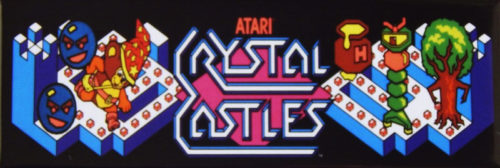 Crystal Castles has nine levels with four castles each, and a tenth level which features a single castle — the clearing of which ends the game. Each of the 37 trimetric-projected castles consists of a maze of hallways filled with gems and bonus objects, and also includes stairs, elevators and tunnels that the player can use as shortcuts. The three-letter initials of the player with the highest score are used to form the first level’s castle structure. When all gems in a castle have been collected, the player moves on to the next castle. The player can also skip some castles and acquire additional lives and points by using secret warps activated by making Bentley Bear jump at special locations. A trackball and “jump” button are used for controlling Bentley Bear’s motions. Gems are collected by simply walking over them, and a bonus is given upon collection of the last gem. While collecting gems, there are a number of enemies that try to stop Bentley and/or collect the gems for themselves. With two exceptions, if touched by the enemies he will lose one of his lives. Any gems collected by the enemies also result in a lower obtainable score for that screen. Likewise, if the last available gem is collected by the enemy, the player also loses the last gem bonus. Enemies can be avoided by use of the maze and its constructs, or by making Bentley jump over opponents with the jump button, in some cases also allowing him to stun them. Some types of enemies will track Bentley’s movements in certain ways, while others move at random. If Bentley is touched, he “cries out” in a distinctive manner with the use of a cartoonish word balloons. If 3 or more lives remain, he says “BYE!”; if 2 lives still remain, the quotation is “OH NO!”; if 1 life is left, it is “OUCH!”; and finally, for the last lost life (which ends the game), he says “#?!”, so as to imitate an obscenity. At the beginning of every maze, gems are worth 1 point each; this value increases by 1 for every gem Bentley picks up, to a maximum of 99. Each maze also randomly includes a hat or honey pot, which serve the dual purpose of awarding points and providing Bentley with the ability to defeat specific enemies. The hat is worth 500 points and will make Bentley invulnerable for a few seconds and allow him to eliminate Berthilda the witch, who appears in the last maze of each level. The honey pot is worth 1,000 points, and picking it up can delay the landing of a swarm of bees. Other villains present in the game include: “Nasty Trees” which become more ornery as levels progress, a ghost that will usually appear in the Hidden Spiral levels, dancing skeletons, “Gem Eaters” who Bentley Bear can defeat if he catches them while eating a gem, and also the devilish “Crystal Balls” creatures that in later levels tend to follow Bentley Bear persistently as he collects gems. The Nasty Trees and Crystal Balls can also pick up gems. Crystal Castles contains two notable easter eggs. Jumping 100 times or more in the southeast corner of level 1?1 and clearing the maze of all gems will make ATARI appear on level 1?2.[2] On level 5?4, if the player kills Berthilda and goes to the corner of the area where she was and jumps, “FXL” will appear in the southeast corner of the screen. These are the initials for Franz X. Lanzinger, a designer of Crystal Castles.
Crystal Castles has nine levels with four castles each, and a tenth level which features a single castle — the clearing of which ends the game. Each of the 37 trimetric-projected castles consists of a maze of hallways filled with gems and bonus objects, and also includes stairs, elevators and tunnels that the player can use as shortcuts. The three-letter initials of the player with the highest score are used to form the first level’s castle structure. When all gems in a castle have been collected, the player moves on to the next castle. The player can also skip some castles and acquire additional lives and points by using secret warps activated by making Bentley Bear jump at special locations. A trackball and “jump” button are used for controlling Bentley Bear’s motions. Gems are collected by simply walking over them, and a bonus is given upon collection of the last gem. While collecting gems, there are a number of enemies that try to stop Bentley and/or collect the gems for themselves. With two exceptions, if touched by the enemies he will lose one of his lives. Any gems collected by the enemies also result in a lower obtainable score for that screen. Likewise, if the last available gem is collected by the enemy, the player also loses the last gem bonus. Enemies can be avoided by use of the maze and its constructs, or by making Bentley jump over opponents with the jump button, in some cases also allowing him to stun them. Some types of enemies will track Bentley’s movements in certain ways, while others move at random. If Bentley is touched, he “cries out” in a distinctive manner with the use of a cartoonish word balloons. If 3 or more lives remain, he says “BYE!”; if 2 lives still remain, the quotation is “OH NO!”; if 1 life is left, it is “OUCH!”; and finally, for the last lost life (which ends the game), he says “#?!”, so as to imitate an obscenity. At the beginning of every maze, gems are worth 1 point each; this value increases by 1 for every gem Bentley picks up, to a maximum of 99. Each maze also randomly includes a hat or honey pot, which serve the dual purpose of awarding points and providing Bentley with the ability to defeat specific enemies. The hat is worth 500 points and will make Bentley invulnerable for a few seconds and allow him to eliminate Berthilda the witch, who appears in the last maze of each level. The honey pot is worth 1,000 points, and picking it up can delay the landing of a swarm of bees. Other villains present in the game include: “Nasty Trees” which become more ornery as levels progress, a ghost that will usually appear in the Hidden Spiral levels, dancing skeletons, “Gem Eaters” who Bentley Bear can defeat if he catches them while eating a gem, and also the devilish “Crystal Balls” creatures that in later levels tend to follow Bentley Bear persistently as he collects gems. The Nasty Trees and Crystal Balls can also pick up gems. Crystal Castles contains two notable easter eggs. Jumping 100 times or more in the southeast corner of level 1?1 and clearing the maze of all gems will make ATARI appear on level 1?2.[2] On level 5?4, if the player kills Berthilda and goes to the corner of the area where she was and jumps, “FXL” will appear in the southeast corner of the screen. These are the initials for Franz X. Lanzinger, a designer of Crystal Castles. -
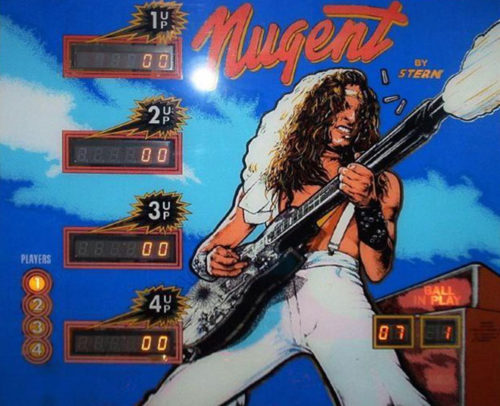
-
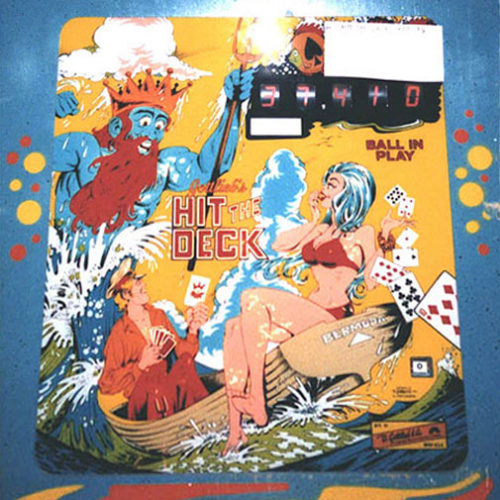
-
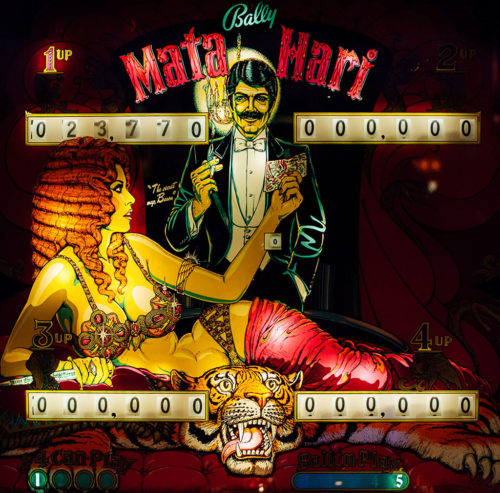 Mata Hari was released in April of the year and designed by Jim Patla with artwork accolades going to Dave Christiansen. 16,200 of these machines were produced in the new solid-state format (as seen in the museum) as well as bunch of electromechanical machines (170, to be exact) to keep the non-computer savvy operators happy and buying machines they knew how to fix. This machine before you is one of the finest examples of this ultra-rare mechanical format. Like the solid-state version, the center kickout hole scores 3,000 points and each successful shot in the hole advances the bonus multiplier. The A and B skill shots advance the horizontal sequence of increasing values in the center of the playfield. 50,000 points are awarded when a battery of drop targets is hit. If both batteries are knocked down, the drop targets reset and hitting all again awards the replay. Score is another replay option.
Mata Hari was released in April of the year and designed by Jim Patla with artwork accolades going to Dave Christiansen. 16,200 of these machines were produced in the new solid-state format (as seen in the museum) as well as bunch of electromechanical machines (170, to be exact) to keep the non-computer savvy operators happy and buying machines they knew how to fix. This machine before you is one of the finest examples of this ultra-rare mechanical format. Like the solid-state version, the center kickout hole scores 3,000 points and each successful shot in the hole advances the bonus multiplier. The A and B skill shots advance the horizontal sequence of increasing values in the center of the playfield. 50,000 points are awarded when a battery of drop targets is hit. If both batteries are knocked down, the drop targets reset and hitting all again awards the replay. Score is another replay option.